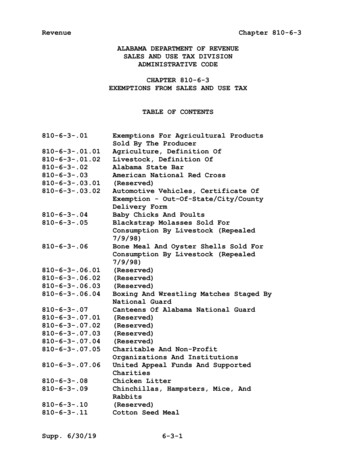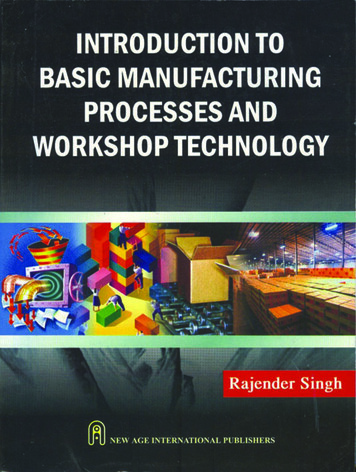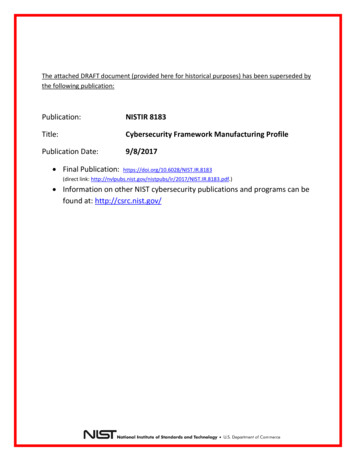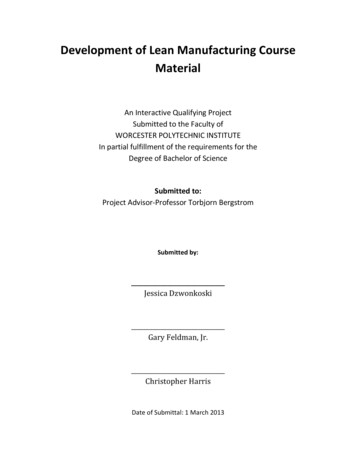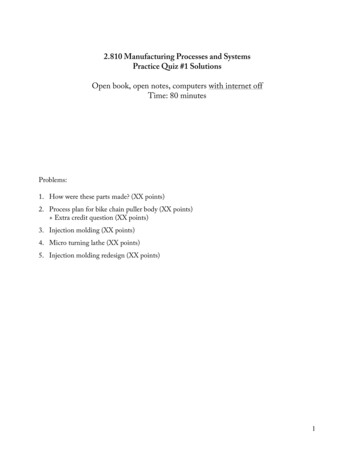
Transcription
2.810 Manufacturing Processes and SystemsPractice Quiz #1 SolutionsOpen book, open notes, computers with internet offTime: 80 minutesProblems:1. How were these parts made? (XX points)2. Process plan for bike chain puller body (XX points) Extra credit question (XX points)3. Injection molding (XX points)4. Micro turning lathe (XX points)5. Injection molding redesign (XX points)1
1. How were these parts made? (XX points)Examine the electrical connector that you were given. For each of the four part types, identify thematerials, the primary processes, and the secondary processes (if any) used to manufacture it. Besure to list the reasons why you decided upon the materials and manufacturing processes that youlisted. You may draw on the picture below to point out features or details that you are referring to.1Part2Material(s)34Reasons1ZincAppearance (soft alloy), weight (heavier thanAluminum), good material to die cast2ZincSame as above3SteelInexpensive, stamped part4SteelTypical material for screws; inexpensivePartProcess(es)ReasonsHigh volume part, cheap, no undercuts, appears to besoft and easy to die cast1Die cast (some postprocess machining)2Die castParting line is clearly visible3Stamped and formed;galvanized (Zn plated)Edge finish; constant thickness4Threads rolled in wirestock; headed and slotmade by formingTypical screw production process; slot turning2
2. Process plan for bike chain puller body (XX points)The bike chain puller “tool body” shown on the following page can be made from hexagonal steelstock by machining. Assume it has already been cut and machined to length. Please write downthe process steps to make the features listed below and called out on the drawing:1. three lands of different widths,2. radiused slot,3. hole in base.For each feature, identify the machines, tools, and fixtures needed for each operation, and thesequence of operations required. For each feature that you machine, sketch a simple schematicshowing your set-up, namely the positions of the part, fixture, and tool. Your sketch should alsoshow the orientation of the part. Point out any part of a feature that is particularly difficult tomake. Use the blank process plan sheet that is provided.You do not need to estimate times. You only need to write a process plan.All dimensions are in inches. Unless otherwise indicated, tolerances are 0.005 inches. Pleasestate all assumptions clearly.Extra credit (XX points)a) Write down the process steps to make the following features:4. horizontal threaded hole,5. radiused profile on ridges between lands.b) Estimate the time to machine feature 1.3
4
#MachineToolOperationFixtureSketch5
Process plan for bike chain puller body: Illustrated solutionPlease note that these answers represent only one possible way to manufacture this component;there are a variety of feasible and correct answers. Tool images are from McMaster.com.Feature 1. Use a flat end mill to clear out the required material, possibly using largerendmills where possible (multi-tool strategy). Could be done on a manual or CNC threeaxis mill.Another option: use peripheral mills to machine away material. Again, multiple widths could beused, but the smallest would need to be 0.100”.6
Feature 2. Fixture the work piece as shown and use a 3/16” flat end mill to create the slot. Couldbe done in a manual or CNC mill.Feature 3. Use a 3/16” center-cutting flat end mill to create the hole since it needs to have asquare bottom. You could also spot drill and drill the hole first to remove most of the material,but would need to finish with the flat end mill. Reaming is likely not required to hold a toleranceof 0.002”, particularly if using an end mill.Feature 4. Use a letter ‘I’ drill (0.272” diameter) to create the hole, after spot drilling. Then, use a5/16-24 tap to create the threads. The hole could be cut on a drill press or mill, and the tappingcan be done manually.7
Feature 5. This is a tricky feature to create because it is more than a half-circle. To cut thisfeature, you need to use a T-slot cutter (so that the shaft is much smaller than the cuttinghead) and approach through either the slot (#2) or the threaded hole (#4, do this beforetapping so you don’t damage the threads). Because this feature is an odd diameter, you need touse circular interpolation to create the surface, limiting you to a CNC mill (a rotary table on amanual mill would likely not hold the required tolerances).Things to consider if mass-producing this part: Create a custom form tool for feature #1 Create custom tooling (correct diameter) for #5 Set up a CNC mill to both drill and tap #4 Consider having a near-net shape component (i.e. forging) made, then finishmachine the critical features. This would eliminate all of the rough machining andthus reduce overall machining time. Consider the time and material savings versusthe cost of tooling for forging.8
3. Injection molding (XX points)Look at this tape cassette case carefully. You only need to consider the top cover, shownin pictures 1 and 3. Estimate some basic parameters about the nature of themanufacturing process used to make this part.Picture 1. Top cover.Picture 2. Cassette case with top open.Picture 3. Top cover.a) Estimate the clamping force (in pounds force), if the dimensions L x W x H are 3.94in x 2.69 in x 0.75 in.The clamping force depends on the projected area of the part and the maximumpressure in the mold during filling. The projected area of this part is L x W (since thisis a rough estimate, we can neglect the additional projected area of the runners):A 3.94 in x 2.69 in 10.60 in29
The maximum pressure during mold filling depends on the material. This case ismade from polystyrene, so using the values provided by Boothroyd (Table 8.5), theinjection pressure should be:P 965 bars 14,000 psiThen we can find the required clamping force:F [lbs] P [psi] x A [in2]F 14,000 psi x 10.60 in2 148,400 lbs 74.2 tonsUnit conversions:1 bar 14.5 psi1 ton 2000 lbsb) Estimate the cooling time (in seconds), if the thickness of the plastic is 1/12 in.You could use two ways to estimate the cooling time. The first approach is to use theformula from lecture for a rough estimate:(ℎ/2)!𝑡!""# 𝛼whereℎ wall thickness 1/12 in 2.1 mm𝛼 thermal diffusivity of polymers 10-3 cm2/s 0.1 mm2/s𝑡!""# (2.1/2)!1.1025 11 𝑠𝑒𝑐0.10.1The second approach is by using Equation 8.5 from Boothroyd for the cooling timeand plugging in values from Table 8.5 for polystyrene:𝑡!""# !ℎ!"#4 𝑇! 𝑇!ln!𝜋 𝛼 𝜋 𝑇! 𝑇!whereℎ!"# maximum wall thickness 2.1 mm𝛼 thermal diffusivity of the polymer 0.09 mm2/s𝑇! polymer injection temperature 218 C𝑇! mold temperature 27 C𝑇! part ejection temperature 77 C𝑡!""# 2.1!4 218 27764ln 4.965ln 7.9 𝑠𝑒𝑐𝜋 ! 0.09 𝜋 77 2715710
c) Make a sketch of the tooling needed to make this part. Point out the gate locationand the special tooling features required, if any.11
4. Micro turning lathe (XX pts)Consider the micro-turning lathe shown above. This lathe is capable of turning anL 1 mm long aluminum needle with a diameter of d 65 µm using a polycrystallinediamond, PCD, tool. The spindle speed was n 10,000 rev-min-1 resulting in a cuttingspeed of vc 2 m/min while the feed was f 0.12 µm and the depth of cut ap 2 µm. Theelectrical power required for this machine is 65 W.a) Estimate the material removal rate in cm3/sec.12
b) Estimate the electrical energy used per unit volume of material removed (in kJ/cm3)and unit mass removed (in J/kg).c) How does this “energy intensity” compare with more conventional machining, whichis generally in the range of 1 – 10 MJ/kg removed?13
14
5. Injection molding redesign (XX pts)A flat rectangular part with dimensions L x W x H is successfully injection molded attemperature T and filling velocity V through a single end gate. A modified design of thispart has decreased each dimension by 30%. It is planned to mold this part at the sametemperature and velocity. A manufacturing engineer suggests that you may run the risk ofa short-shot. Do you agree? Please justify your answer with an analysis.WHGate LocationLHere we are concerned with the ratio of the flow rate to the heat transfer rate. The flowtime can be calculated as:𝐿 𝑣𝑡!"# where v filling velocity, L length of part𝐿𝑡!"# 𝑣The cooling time can be estimated as:𝑡!""# (𝐻/2)!𝐻! 𝛼4𝛼where 𝐻 thickness of part, 𝛼 thermal diffusivity of polymers 10-3 cm2/sThen their ratio for the original part dimensions is:1𝑡!"# 𝐹𝑙𝑜𝑤 𝑟𝑎𝑡𝑒𝑡!""# 𝐻 ! 𝑣 1𝐻𝑒𝑎𝑡 𝑡𝑟𝑎𝑛𝑠𝑓𝑒𝑟 𝑟𝑎𝑡𝑒𝑡!"# 4𝛼𝐿𝑡!""#For the modified smaller part, at the same temperature and velocity, the ratio is:𝐹𝑙𝑜𝑤 𝑟𝑎𝑡𝑒(0.7𝐻)! 𝑣𝐻!𝑣 0.7𝐻𝑒𝑎𝑡 𝑡𝑟𝑎𝑛𝑠𝑓𝑒𝑟 𝑟𝑎𝑡𝑒 4𝛼(0.7𝐿)4𝛼𝐿A lower ratio implies higher possibility of a short shot (see Injection Molding lecturenotes on Non-Isothermal Flow). We can also see that just by looking at the times: for themodified design,𝑡!"# 𝑡𝑐𝑜𝑜𝑙 0.7𝐿 30% 𝑟𝑒𝑑𝑢𝑐𝑡𝑖𝑜𝑛 𝑓𝑟𝑜𝑚 𝑜𝑟𝑖𝑔𝑖𝑛𝑎𝑙 𝑓𝑙𝑜𝑤 𝑡𝑖𝑚𝑒𝑣(0.7𝐻/2)2𝛼 0.49𝐻24𝛼 51% 𝑟𝑒𝑑𝑢𝑐𝑡𝑖𝑜𝑛 𝑓𝑟𝑜𝑚 𝑜𝑟𝑖𝑔𝑖𝑛𝑎𝑙 𝑐𝑜𝑜𝑙𝑖𝑛𝑔 𝑡𝑖𝑚𝑒The cooling time decreases more than the flow time, so there is indeed risk of a shortshot (the part might solidify before the entire mold is filled).15
2.810 Manufacturing Processes and Systems Practice Quiz #1 Solutions Open book, open notes, computers with internet off Time: 80 minutes Problems: 1. How were these parts made? (XX points) 2. Process plan for bike chain puller body (XX points) Extra credit question (XX points) 3. Injection

